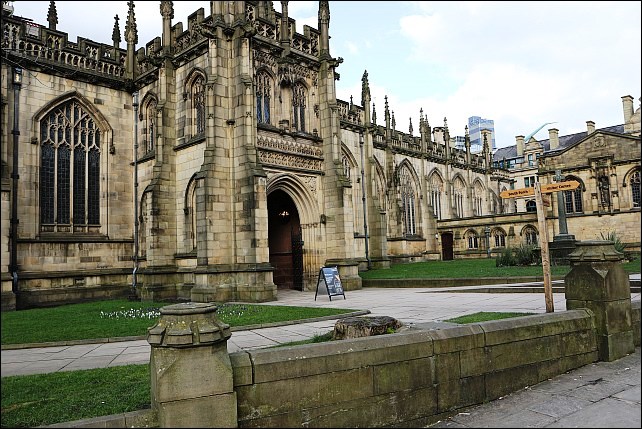
Manchester Cathedral
Winter Visit 2018
The winter visit of the Society comprised of guided tours of two venues, the Greater Manchester police station and Manchester Cathedral, last visited by in the 1990s and early 2000s.
The Police Museum is the former Newton Street Police Station, the building from 1879 houses the original Victorian cells with their wooden pillows and the Charge office of Newton Street Police Station where time has stood still for over 120 years. Amongst the other attractions are historic police equipment and uniforms from the region. Uncover the fascinating world of forgery and forensic science.
Manchester Cathedral gained status in 1847, though its history dates from 1421. In 1940 a German bomb destroyed most of the north-east of the Cathedral and causes extensive damage to the rest of the building. All was not lost, the Cathedral still boasts 17th century wood carvings, together with modern stained glass.
Greater Manchester Police Museum
Hazel Meakin
We were given an excellent and very informative tour of the Greater Manchester Police Museum by retired policeman Ron Flowers who was dressed in the typical uniform worn between 1880 – 1950's.
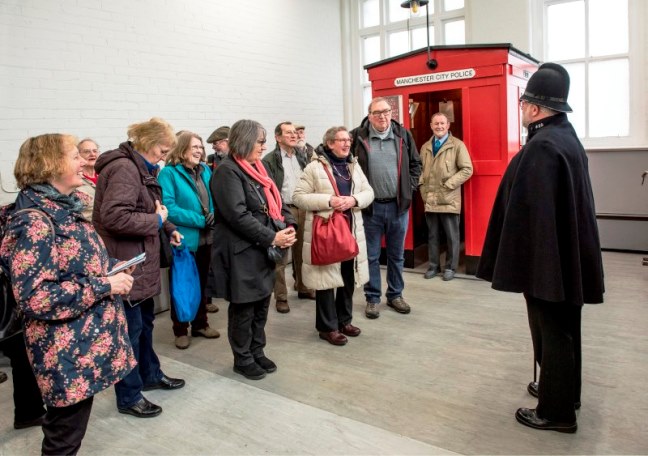 Pay attention in the rankThe museum is housed in the former Newton Street Police Station which still has its Victorian cells and charge office and has the 1895 Magistrates Court from Denton Police Station. Newton Street station was built around 1878/79 and was literally “built like a fortress” with steel reinforced walls to withstand attack from the Fenians and Irish Republican Brotherhood who were active at the time.
Pay attention in the rankThe museum is housed in the former Newton Street Police Station which still has its Victorian cells and charge office and has the 1895 Magistrates Court from Denton Police Station. Newton Street station was built around 1878/79 and was literally “built like a fortress” with steel reinforced walls to withstand attack from the Fenians and Irish Republican Brotherhood who were active at the time.
Policing in Manchester started in 1839 when a policeman was expected to work a 12/14 hour shift, 7 days a week with no holidays! Police officers had to be a minimum of 6 feet tall and able to read, write and fight! Their pay was roughly equivalent to that of a teacher and therefore attracted tall (and probably broad) young men from all over the country. These early policemen were expected to live at home but their homes were vetted to ensure that they were suitable. Lodging in public houses was definitely not allowed!
They ventured forth on the streets armed with a truncheon, bulls eye lantern and rattle and snaps (the forerunners of the whistle and handcuffs). Ron regaled us with stories of their encounters with the scuttler street gangs of Ancoats in the “rough old days”.
The museum has lots of displays ranging from uniform and helmets through the ages to unusual offensive weapons used in local incidents! The display of prominent local murders is a bit like a list of Agatha Christie novels. The Kingsway Murder and the Jigsaw Murder being two examples.
Our visit to the charge office was like stepping back in history. This was the hub of any police station and has all its original fittings including an early, but effective, copying device. After a wander around the bleak and uncomfortable holding cells, our last port of call was the Magistrates Court. Here Ron told us the poignant tale of Jenny Jones, a 6 year old accused of stealing an apple and sentenced to 5 years at an industrial school. Apparently the magistrates of the time thought they were doing such individuals a favour by taking them off the streets and giving them food and shelter.
For those of us interested in family history, the museum also holds records of the policemen who enrolled in the Manchester police force from 1858 -1918. They also have Alien Registers for early immigrants to Manchester many of whom were escaping from the pogroms in Russia and Poland in the later 1800's.
There's lots for all ages to see and learn about at the museum and I will definitely be making a return visit. Many thanks to Judith for arranging the visit for us.
Manchester Cathedral
Margaret Bradbury
We entered through the South door to be greeted by our two friendly guides, who wore distinctive sashes of red with three diagonal gold stripes –the colours of the de Gresle shield which is in the middle of the Manchester coat of arms, as well as being the Cathedral crest. This family were the Norman barons of Manchester who built a stone church on this site by the 13th century, next door to their fortified manor house, now Chetham’s, replacing its Norman predecessor. The oldest artefact in the Cathedral is the 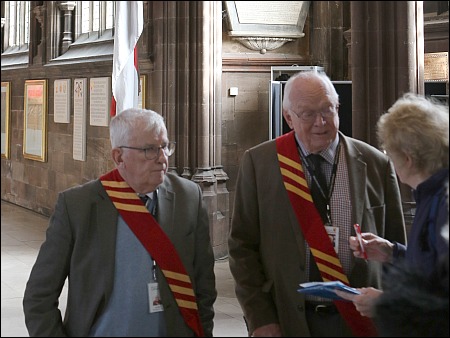 The guides receive their instructionsSaxon “Angel Stone”, a small carving of an angel holding a scroll and the words interpreted as “into thy hands I commend my spirit”, which is probably 9th century and was found in 1871 during excavation work in the area of the South porch.
The guides receive their instructionsSaxon “Angel Stone”, a small carving of an angel holding a scroll and the words interpreted as “into thy hands I commend my spirit”, which is probably 9th century and was found in 1871 during excavation work in the area of the South porch.
(left:)
The Nave is the widest in the country, no walls dividing it from the aisles because the chantry chapels were swept away at the Reformation, and the later galleries and balconies removed. I was pleasantly surprised at how warm it is, due to the geothermal underfloor heating of the new stone floor, one initiative in a comprehensive Development Project to enhance the experience of visitors and worshippers alike, running up to the celebration in 2021 of the 600-year anniversary of the Henry V charter (1421) which transformed the parish church into the collegiate church of Manchester, under Thomas de la Warre who was both Rector and Baron! The Collegiate Foundation was dedicated to St Mary, St George and St Denys, Patron Saint of France, for at this time Henry V claimed the French throne. The church was almost completely rebuilt, having seating arranged in rows facing north and south like the chapels of the older university colleges, and would have a “college” of priests to pray and study, and singing men, under a Warden. The priests’ college with Great Hall and cloistered lodgings was built on the site of the manor house: it remains the most intact example in the country. (Now within Chetham’s)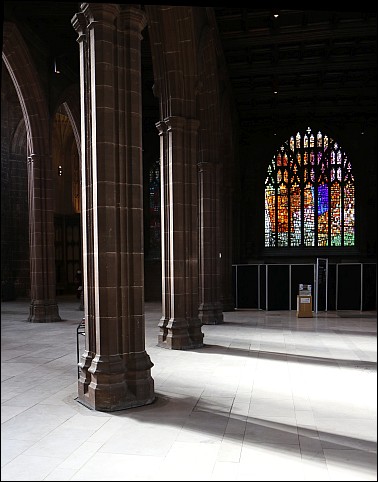
The rather dark coloured stone of the pillars and walls is Colleyhurst sandstone, used to restore the interior in the 1880s. The Tower arch in the West wall, predating 1421, shows damage caused by picks when the stone was roughened to take a coating of 19th century “Roman” cement, which later fell off! The base of the bell tower is a lofty space with splendid Gothic ceiling and wall panels recording the names of those connected with the Church and Cathedral. The Collegiate Church became a Cathedral in 1847, when the Diocese of Manchester was created to reflect the change from a small market town to the world’s first industrial city.
The five West Windows have dazzling modern stained glass (1973-1995) replacing those destroyed in World War 2, and represent Creation, Saint George, Saint Mary, Saint Denys, Book of Revelation.
The wall of the North Aisle has a striking group of paintings in the style of Eastern Orthodox Icons, representing Saint Denis; Mary; the Holy Family as Abraham, Sarah and Isaac; Jesus; and Saint George.
The ceiling of the Nave has carved wooden Minstrel Angels playing stringed and wind instruments, presented by Margaret Beaufort after the Battle of Bosworth (1485) as thanks to Lord Stanley whose army of men from Lancashire and Cheshire supported her son, Henry Tudor, in the battle.
The Screen separates Nave and Quire and is a fine example of medieval oak carving. It had to be strengthened to support the new £2.6 million Stoller Organ installed in 2017 and paid for by the Stoller Charitable Trust run by the Oldham-based businessman and philanthropist Sir Norman Stoller. It was built by Tickells, with over 4800 pipes, from 6 inches to 32 feet high; gilded by hand and quite stunning. It can be played from either the mechanical-action screen console or an ingenious mobile electric-action console in the Nave. The pipe shades, carved from solid o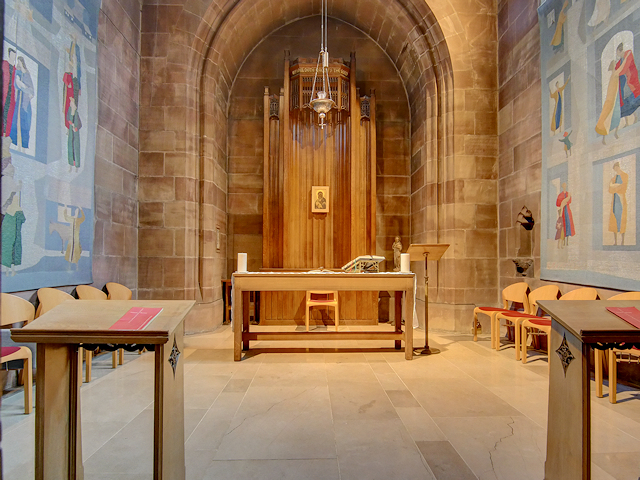 ak, have cut-through words from the Latin liturgy to release the sound.
ak, have cut-through words from the Latin liturgy to release the sound.
We now entered the Quire, heart of the medieval church where the clergy came from their college to worship several times a day. There is carving of amazing intricacy high above the seats, which tip up to reveal 16th century misericords with fabulous comic scenes, some of the best in Europe, showing everyday life and legends, On the arch above the Lady Chapel we saw a rebus, or riddling representation, a man hunting with a dog, and a man with two huge barrels (tuns) giving “hunting-tun” commemorating John Huntington the first Warden, who undertook the building of the Quire at his own expense. The Cathedra, or Bishop’s throne, was erected in 1855. The Lady Chapel (above) was destroyed in the Blitz, but it has been rebuilt in simple style for Holy Communion and meditation, with a modern icon over the altar. The new East door next to the chapel leads to a statue on the outside wall of “Our Lady of Manchester”, dressed as a millworker, in the recently landscaped Cathedral Gardens.
The North Aisle shows Manchester’s involvement in the slave trade, through slave-grown cotton, traded for captured Africans. In 1787 Thomas Clarkson, (who collected the evidence that persuaded Wilberforce to support Abolition in Parliament) was invited to denounce slavery at the Cathedral to a huge audience, the first mass meeting of the campaign, leading to the Manchester Anti-Slavery Committee petition of over 10,500 names. We also saw the plaque dedicated to Joshua Brookes, Chaplain for 30 years from 1790; uncouth and outspoken but amiably eccentric, who lived at a time of such rapid growth in the population of Manchester that he conducted 30 marriages at a time, some by proxy; in fact he conducted more baptisms, weddings and funerals per year than anyone else in the country. He appears under his own name in “The Manchester Man” by Isabella Banks.
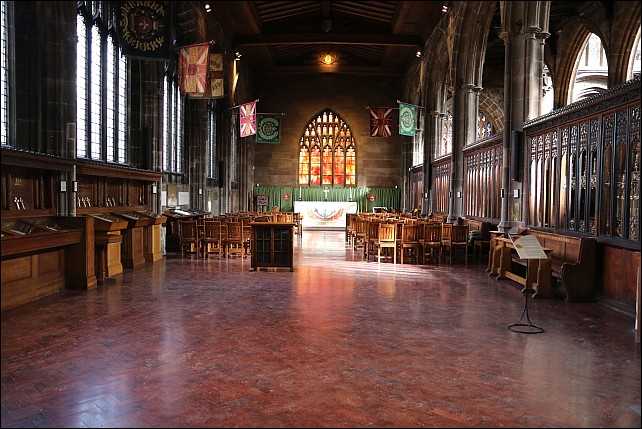 Chapel of the Duke of Lancaster’s Regiment
Chapel of the Duke of Lancaster’s Regiment
Next, we visited the Chapel of the Duke of Lancaster’s Regiment, here since 1936, in what was the John the Baptist Chantry. It is lit by the remarkable Fire Window which commemorates the Cathedral’s rebuilding after the north east corner was destroyed in the 1940 Blitz. The window itself needed reconstruction after the 1996 IRA bombing. Nearby is the Hope Window, the last of the new windows, showing textile patterns relating to the cotton industry, and a bee, the symbol of Manchester. The statue of Sir Humphrey Chetham of 1853 looks magnificent in front of this window, linking the shared histories of city, Cathedral, Chetham’s Library and the School of Music where the choristers are educated.
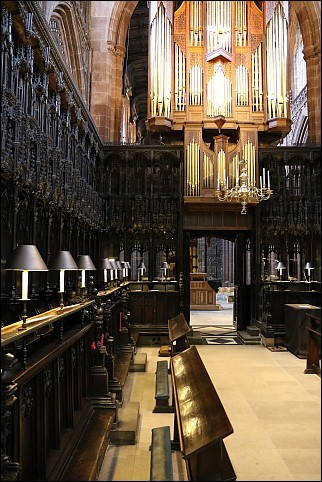 Choir stalls and organTurning the corner to the South Aisle is the Fraser Chapel, built in 1887 as a memorial to Bishop Fraser, “the people’s bishop”. His statue also stands in Albert Square. The Victorian atmosphere of this chapel is enlivened by a modern stained glass window and as an altar piece a painted triptych reflecting life in modern Manchester, showing “St George”, with dark skin, releasing the dragon to bring good luck, and a central bridge representing transition. The modern Father, Mother and Son are enjoying a meal with ketchup on the table with glasses of Boddingtons, and St Denys is beheaded but still preaching on a Manchester shopping street.
Choir stalls and organTurning the corner to the South Aisle is the Fraser Chapel, built in 1887 as a memorial to Bishop Fraser, “the people’s bishop”. His statue also stands in Albert Square. The Victorian atmosphere of this chapel is enlivened by a modern stained glass window and as an altar piece a painted triptych reflecting life in modern Manchester, showing “St George”, with dark skin, releasing the dragon to bring good luck, and a central bridge representing transition. The modern Father, Mother and Son are enjoying a meal with ketchup on the table with glasses of Boddingtons, and St Denys is beheaded but still preaching on a Manchester shopping street.
The Chapter House was built when the Collegiate Church was founded, and it was probably redesigned in traditional octagonal pattern about 1500. Heraldic shields decorate the walls, showing people with connections to the Cathedral. In the Jesus Chapel are copies of the Cathedral Charters on the walls, from the first one signed by Henry V. Henry VIII dissolved the College and discontinued the Chantries, Edward VI confiscated the Church plate, Mary re-established the College under the same terms as the first Charter, Elizabeth I signed the Third Charter and Charles I granted the Fourth.
This was a thoroughly enjoyable visit to Manchester’s well-loved Cathedral, which has survived wars and terrorist attacks, and yet the organ plays on!
Photos: David Burridge, Arthur Procter and the internet


























